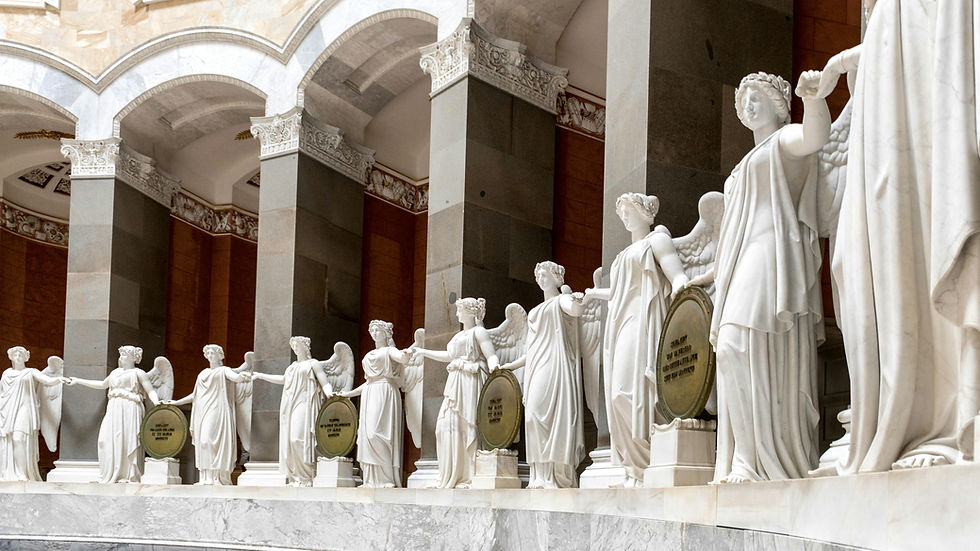Murder of the Hammersmith Ghost
- Katharina Bauer
- Sep 23
- 3 min read
Yes, murder of a ghost...
The tale begins in late 1803, in the quiet London district of Hammersmith. A local rumour began to spread, telling of a ghost that haunted the area. Many people claimed to have seen the apparition, with some even alleging they were attacked by it. The general consensus among locals was that the spectre was the spirit of a man who had died by suicide the year before and had been buried in the local churchyard. At the time, it was believed that the souls of suicide victims would not be at peace if they were buried in consecrated ground.
Descriptions of the ghost varied wildly. While some witnesses described it as being very tall and dressed in all white, others claimed it wore a calfskin garment with horns and large glass eyes. These unsettling stories fuelled a growing sense of fear. Two women, one elderly and the other pregnant, reportedly died from shock a few days after being seized by the ghost. A brewer's servant named Thomas Groom also testified that something had risen from behind a tombstone, seized him by the throat, and then vanished.
With no formal police force in London at the time, armed patrols were formed by concerned citizens to try and catch the ghostly menace. Among these was Francis Smith, a 29-year-old excise officer. On the night of 3rd January 1804, Smith was patrolling the streets with a shotgun, looking for the supposed ghost. Around 11 p.m., he came across a bricklayer named Thomas Millwood, who was on his way home from visiting his family. Millwood was dressed in the usual white clothes of his trade: "linen trousers entirely white, washed very clean, a waistcoat of flannel, apparently new, very white, and an apron, which he wore round him".

According to Millwood’s sister, Anne, Smith challenged the bricklayer, shouting, "Damn you; who are you and what are you? Damn you, I'll shoot you," before firing his shotgun. Smith had tragically mistaken Millwood's white clothing for the shroud of the ghostly apparition. Millwood was shot in the lower left jaw and died instantly. When a constable arrived, Smith was taken into custody.
Francis Smith was subsequently tried for willful murder. The prosecution revealed that Millwood had been warned by his wife to cover his white clothes with a greatcoat, as he had previously been mistaken for the ghost. The chief judge, Lord Chief Baron Sir Archibald Macdonald, made it clear that a mistaken belief could not be used as a defence. He instructed the jury that murder does not require malice, only an intent to kill, and that the case was a "clear case of murder". Macdonald stated that Smith had not acted in self-defence, nor had he shot Millwood by accident. The judge further clarified that even if Smith had shot the actual person pretending to be a ghost, it would not have been justified. Frightening people by pretending to be a ghost was a misdemeanour, not a serious felony that would warrant being shot.
The jury, after deliberating for an hour, returned a verdict of manslaughter. However, the judge refused to accept this verdict, insisting they must find Smith either guilty of murder or acquit him. He stated that Smith's belief that he was shooting a ghost was irrelevant. The jury returned a verdict of guilty. Smith was sentenced to death, but this was later commuted to one year of hard labour. The case's publicity led the true culprit to come forward: an elderly shoemaker named John Graham, who had been using a white sheet to scare his apprentice. There is no record of him ever being punished.
The Hammersmith Ghost case established a legal precedent: someone could be held liable for their actions even if those actions were the result of a mistaken belief. This issue, however, remained a subject of legal debate for 180 years. It was finally clarified in the 1984 Court of Appeal case of Williams (Gladstone). Gladstone Williams had intervened in what he mistakenly believed was an assault, only to injure a man who was actually attempting to apprehend a suspected thief. The appeal court ruled that if a defendant genuinely believed they were acting in self-defence, or to prevent a crime, they could be acquitted, even if that belief was a mistaken one. The unreasonableness of the mistake could be a factor in determining whether the belief was honestly held, but an unreasonable mistake in itself did not negate the defence.



